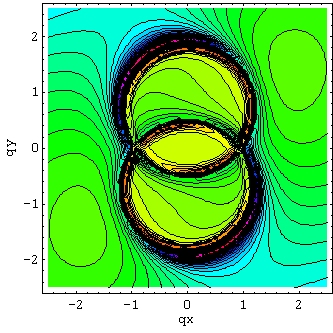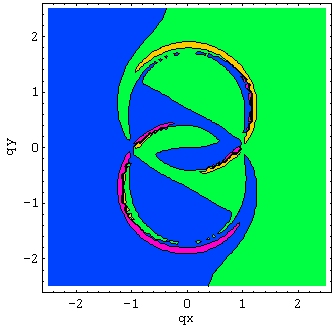Ripples. Simplified picture.
When the incident (i) light (with wavevector
k0=2p
/l
) falls onto the plane surface, it produces
reflected
(r) and
transmitted (t) waves. Their amplitudes are given
by the
Fresnel formulas. If the surface
is not plane but corrugated, diffracted
waves also appear. Because Maxwell equations are linear, it is
enough to consider only one sinusoidal Fourier harmonic
of corrugation. It acts as a diffraction grating. In the first diffraction
order, the anti-Stokes and Stokes waves with parallel to the surface components
of the wavevector
 (1)
(1)
appear. These diffracted waves in the media interfere
with the (t) wave, which results in the periodic energy deposition into
the material. One can expect that the interference will be strongest near
the surface, if diffracted waves
in
the media propagate parallel
to the surface. This yields:
 (2)
(2)
Another possibility for strong interference is that as
a result of diffraction on a
corrugation with wavevector q, surface
electromagnetic wave (SEW) is excited. In many cases
 ,
,
which together with (1) results in a condition
 (3)
(3)
In some cases conditions (2) and (3) may coexist, and
therefore most "dangerous" corrugation wavevectors
-- i.e., those, which yield the strongest modulation of deposited energy
near the surface lie on one or even two circles
in the wavevector space. This simple consideration is confirmed by the
more complicated calculations for the amplitudes of diffracted waves and
their interference with Fresnel (zero order) transmitted wave.
This diffraction
picture can manifest itself in laser ablation experiments
in the following way. If constructive interference takes
place in the valleys of the corrugation, they will be heated
stronger, ablated faster, and corrugation will
increase in time. If it takes place in the humps
of corrugation, ablation will have a stabilizing effect on
it. Other feedback mechanisms are possible, thus making the consideration
of the phase of diffracted waves also important.
Thus, laser ablation (or some other
feedback mechanism) may perform a wavevector selection in the initial stochastic
surface profile where almost all wavevectors are present. This selection
results in certain periodicity
which can be analyzed in a diffraction experiments
of a probe laser beam. Angular diffraction pattern almost reproduces one
of the two ring structure given by (2) or (3).


Calculated dependence of modulation
of energy deposition near the surface as a function of wavevector of surface
corrugation. These circles are due to SEW (3). Second picture shows the
phase
shift between the inhomogeneous part of deposited energy and (sinusoidal)
surface corrugation. Parameters:
e
=-3+0.6i,
plane of incidence (y-z) angle of incidence qi=45°,
circular polarization. For certain material parameters rings (2) and (3)
can bee seen simultaneously.
Home
 (1)
(1)
 ,
,

